Q1. In a cell cycle, DNA replication takes place in
Solution
In the S phase, replication of chromosomes and their DNA occurs with the help of DNA polymerase. Maximum histone protein is synthesised in the S phase. The number of chromosomes remains the same as was present in the cell but each chromosome becomes double stranded.
Q2. In a cell cycle, during which phase are chromosomes arranged on the equatorial
plate?
Solution
During metaphase, the chromosomes get arranged in
the form of a plate called the equatorial plate or metaphase plate at the
equator of the spindle. This plate is at right angles to the axis of the
spindle and is formed of the kinetochores, the arms of chromatids trailing
away. The centromeres are drawn to the equator by the equal pull of two
chromosomal fibres which connect the sister kinetochores to the opposite
poles. The process of drawing the chromosomes onto the equator of the spindle
is known as congression.
Q3. Which stages of cell division do the figures A and B represent?
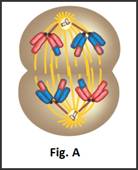
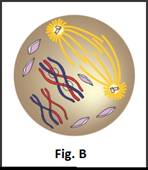


Solution
During anaphase, the sister chromatids move towards the opposite poles. The anaphase ends when all the chromatids reach the opposite poles.
During prophase, the chromosomes become visible and the nucleolus disappears. The mitotic spindle forms and the nuclear envelope disappears.
Q4. The point at which polytene chromosomes appear to be
attached together is called
Solution
Polytene chromosomes are formed by pairing of two somatic homologous
chromosomes which undergo endomitosis forming a number of strands. These
strands remain attached to a large chromocentre and are rich in
heterochromatin.
Q5. How many mitotic divisions are needed for a single
cell to make 128 cells?
Solution
A single mitotic division results in the production of two cells from a
single cell. Therefore, it will be 1, 2, 4, 8, 16, 32, 64, 128....
Q6. Sanjay
observes a cell in the metaphase stage under a microscope. Describe the
structure or appearance of chromosomes which he may have observed.
Solution
Chromosomes are thick and clearly visible.
Their two sister chromatids are visible.
The sister chromatids are held together by the
centromere.
Small disc-shaped structures are visible at the surface of the
centromeres. These structures are called kinetochores, and they provide the
surface of attachment of spindle fibres to chromosomes.
Q7. Where can we study mitosis?
Solution
Mitosis takes place in the nail root at the base of the nail.
Q8. Define meiosis.
Solution
Meiosis is a specialised kind of cell division which reduces the
chromosome number by half resulting in the formation of haploid daughter cells.
Q9. Define crossing over.
Solution
Crossing over is the exchange of genetic material between two
homologous chromosomes.
Q10. Label
the diagram and also determine the stage at which the contents of a cell
appear like the following diagram.
Solution
Metaphase:
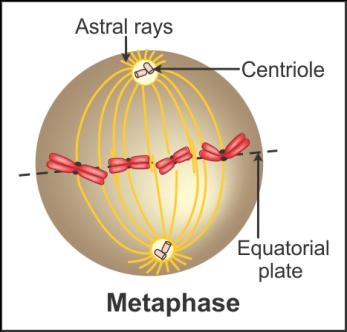

Q11. What is
the function of kinetochores?
Solution
Kinetochores provide the surface for the attachment of spindle fibres
to the chromosomes.
Q12. The yeast
cell can progress through the cell cycle in about
Solution
The duration of the cell cycle depends on the type
of cell and external factors such as temperature, food and oxygen supplies. The
bacterial cell can divide every 20 minutes, while onion root tips may take 20
hours. The mammalian cell divides once in every 24 hours, and a yeast cell may take about 90 minutes.
Q13. At which stage of the cell cycle are histone proteins synthesised in a eukaryotic cell?
Solution
The synthesis of histone proteins takes
place during the S phase of the cell cycle because the number of chromosomes is
double the somatic number.
Q14. Name
the four stages of mitosis.
Solution
The four stages of mitosis are
Prophase
Metaphase
Telophase
Anaphase
Q15. Identify the stage which the following diagram represents.
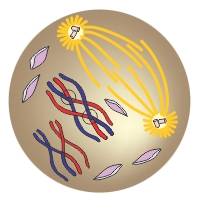

Solution
Prophase I
Q16. Write
the events which occur during the metaphase stage.
Solution
Metaphase:
Spindle fibres attach to kinetochores of
chromosomes.
Chromosomes get aligned in the middle of the
cell on the equatorial plane or metaphase plate.
Q17. State
the event which marks the beginning of prophase during mitosis.
Solution
Initiation of condensation of chromatin material marks the beginning
of prophase during mitosis.
Q18. Which is the longest phase of the cell cycle?
Solution
Interphase is the longest phase of the cell cycle.
Q19. What is the proper sequence in mitosis?
Solution
There are two main events in mitosis - karyokinesis
or duplication of the nucleus, followed by cytokinesis or division of the
cytoplasm. This is followed by the separation of the daughter cells.
Karyokinesis is divided into four stages - prophase, metaphase, anaphase and
telophase.
Q20. Identify the meiotic stage in which the homologous chromosomes separate while the sister chromatids remain associated at their centromeres.
Solution
During anaphase I, two out of each tetrad of chromatids of a chromosome move as a unit to one of the poles of the spindle. The other two chromatids of its homologue migrate to the opposite pole. Therefore, rather than the chromatids of a chromosome, the homologous chromosomes of each pair are separated.
Q21. State the duration of the cell cycle in yeast.
Solution
The duration of the cell cycle in yeast is 90 minutes.
Q22. Explain the events which occur during a pachytene stage.
Solution
The following events occur during the pachytene stage:
Recombination nodules appear.
Homologous chromosomes cross over at the recombination nodules for the exchange of genetic material.
Q23. Meiosis results in
Solution
Meiosis has the following significance:
1. Formation of gametes
2. Formation of spores
3. Maintenance of chromosome number
4. Introduction of variation
5. Mutation
6. Evidence of basic
relationship of organisms
Q24. Match List I and List II, and select the correct answer.
List I (Phase of Meiosis)
List II (Event which occurs)
1. Prophase I
Crossing over occurs
2. Metaphase II
Sister chromatids migrate to opposite poles
3. Anaphase I
Homologous chromosomes line up at the equator in pairs
4. Telophase II
Condensation of chromatin fibres
Solution
Crossing over or recombination occurs during the pachytene stage of prophase I of meiosis. During metaphase II, sister chromatids migrate to opposite poles forming a single metaphase plate. In metaphase I, homologous pairs of chromosomes are spread across the metaphase plate. Progressive condensation and coiling of chromosome fibres occur during the leptotene stage of prophase I of meiosis.
Q25. The best stage to observe the shape, size and number
of chromosomes is
Solution
During the stage of metaphase, the following characteristics can be
easily studied:
1. Least coiled chromosomes
2. Show maximum condensation
3. Chromosomes are shortest in length
Q26. State
the events which take place during prophase.
Solution
Events which occur during prophase:
Chromosomal material condenses into
chromosomes. Chromatids and centromeres are visible.
The mitotic spindle starts forming in the
cytoplasmic microtubules and proteinaceous components of the cytoplasm.
Q27. A mitotic spindle is mainly composed of which
protein?
Solution
Mitotic spindles are nothing but microtubules made of small units of tubulin which have amino acid composition similar to
actin.
Q28. Synapsis occurs in which of the following stages of meiosis?
Solution
Synapsis is the pairing of
homologous chromosomes. It allows matching of homologous pairs of chromosomes
before their segregation and possible chromosomal crossover between them. Synapsis occurs during the
zygotene stage of prophase I
of meiosis.
Q29. At which stage of mitosis do chromatids separate and pass to different poles?
Solution
During anaphase of mitosis, the chromosomes split and the sister chromatids of each chromosome move towards the opposite poles. The separation of chromatids begins at the kinetochore and the arms trail behind. Therefore, the chromosomes are pulled into V, L, J and I shapes based on the position of the kinetochore.
Q30. Define bivalents.
Solution
Bivalents are the homologous chromosomes which are paired during the
zygotene stage of prophase I in meiosis.
Q31. Distinguish
between the cytokinesis of plant cell and animal cell.
Solution
Cytokinesis of Animal Cell
Cytokinesis of Plant Cell
A
furrow appears in the plasma membrane.
Cytokinesis
begins with the formation of the cell plate in the middle of the cell.
The
furrow deepens and joins the centre dividing the cell into two
daughter cells.
The
cell plate grows from the centre outwards, dividing the cell into two
daughter cells.
Q32. Draw the diagrams of
Transition to metaphase
Anaphase
Solution
Transition to Metaphase:
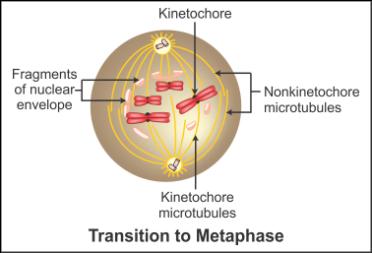 Anaphase:
Anaphase:
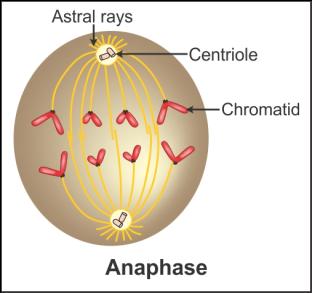
 Anaphase:
Anaphase:

Q33. Name
the stage during which chromatids start moving to the opposite poles.
Solution
Anaphase
Q34. Draw a diagram
of the cell cycle indicating the formation of two new daughter cells from the
parent cell.
Solution
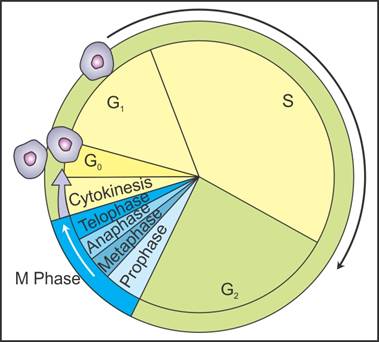
Q35. During meiosis, crossover occurs between
Solution
Some of the essential features of meiosis include:
1. Two consecutive divisions without DNA replication between them
2. Synapsis of homologous chromosomes
3. Crossing over of segments between non-sister chromatids of homologous chromosomes
4. Segregation of homologous chromosomes
5. Separation of sister chromatids
Q36. Name the enzyme involved in crossing over.
Solution
Recombinase
Q37. Identify
the phase shown in the following diagram.
Solution
Late Prophase:
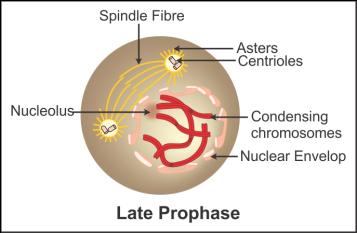

Q38. Describe
the quiescent stage of the cell cycle.
Solution
Some cells do not exhibit cell division or some
cells divide only when the body has lost cells during an injury. Such cells
enter the quiescent stage.
In this stage, the cells are metabolically active.
However, the cells do not divide.
They undergo division only when there is a requirement by the body
under certain conditions.
Q39. What
does the cell plate represent?
Solution
The cell plate represents the middle lamella between the walls of the
adjacent cells.
Q40. Define
cell cycle.
Solution
The sequence of events during which a cell duplicates its genome,
synthesises its other constituents and eventually divides into two daughter
cells is called the cell cycle.
Q41. Identify
the stages during which the following events occur in M phase:
Spindle fibres attach to the kinetochores of
chromosomes.
Golgi complex and endoplasmic reticulum
disappear.
Daughter chromosomes begin their migration
towards the opposite poles.
Centromere splits.
Solution
Spindle fibres attach to the kinetochores of
chromosomes - Metaphase
Golgi complex and endoplasmic reticulum
disappear - Prophase
Daughter chromosomes begin their migration
towards opposite poles - Anaphase
Centromere split - Anaphase
Q42. Why is
mitosis also called equational division?
Solution
During mitosis, the number of chromosomes in the parent and progeny
cells is the same. Hence, it is also called equational division.
Q43. Write
the three phases which are collectively known as interphase.
Solution
Three phases which are collectively known as the interphase are
G1 phase
S phase
G2 phase
Q44. Name the following:
Complex structure formed during synapsis
The stage between two meiotic divisions
The sites at which the homologous chromosomes
remain unseparated during prophase I
Enzyme involved in crossing over
Solution
Complex structure formed during synapsis -
Synaptonemal complex
The stage between the two meiotic divisions - Interkinesis
The sites at which the homologous chromosomes
remain unseparated during prophase I - Chiasmata
Enzyme involved in crossing over - Recombinase
Q45. What are recombination nodules?
Solution
Recombination nodules are the sites at which crossing over occurs
between two non-sister chromatids of the homologous
chromosomes during the pachytene stage.
Q46. Diagrammatically represent the chromosomal arrangement during the M phase of a cell with four chromosomes of organism X.
Solution
Early Prophase:
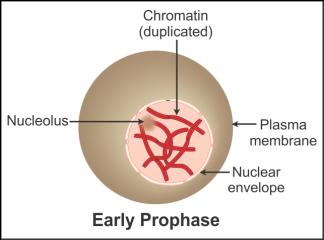 Late Prophase:
Late Prophase:
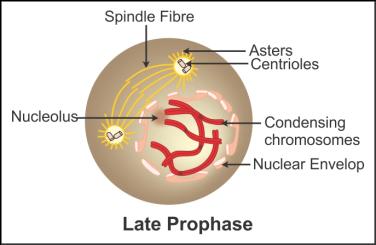 Metaphase:
Metaphase:
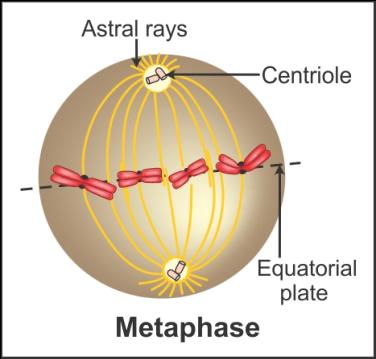 Anaphase:
Anaphase:
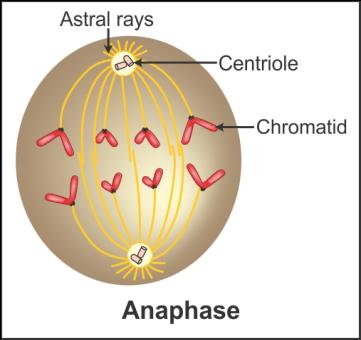 Telophase and Cytokinesis:
Telophase and Cytokinesis:
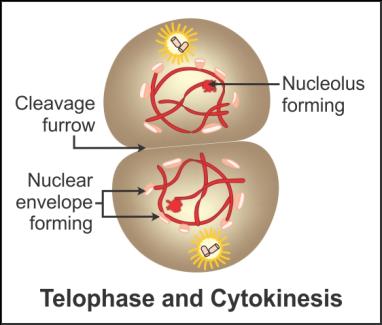
 Late Prophase:
Late Prophase:
 Metaphase:
Metaphase:
 Anaphase:
Anaphase:
 Telophase and Cytokinesis:
Telophase and Cytokinesis:

Q47. Describe
the process of cytokinesis in plant cells.
Solution
In plant cells, the precursors of the cell wall,
i.e. the cell plate, are formed in the centre of the cell.
The cell plate grows from the middle of the cell
outwards, dividing the cell into two daughter cells.
The cell plate represents the middle lamella between the walls of two
adjacent cells.
Q48. Distinguish between anaphase I of meiosis and anaphase of mitosis.
Solution
Anaphase I of Meiosis
Anaphase of Mitosis
Centromeres split and chromatids separate.
Homologous chromosomes separate.
Chromatids move to opposite poles.
Sister chromatids remain associated at their centromeres.
Q49. Differentiate between mitosis and meiosis.
Solution
Mitosis
Meiosis
Two
daughter cells are formed.
Four
daughter cells are formed.
Cytoplasm
and nucleus divide once during cell division.
Cytoplasm
and nucleus divide twice during cell division.
Number
of chromosomes in daughter cells and parent cell is the same.
Number
of chromosomes in daughter cells is half the number of chromosomes in
parent cell.
Mitosis
occurs in diploid cells, but it also occurs in some haploid cells.
It
occurs in diploid cells.
It
helps in growth and cell repair in organisms.
It
helps maintain a constant number of chromosomes in a species.
Q50. Name
the stage at which the morphology of chromosomes can be studied.
Solution
The morphology of chromosomes can be studied at metaphase.
Q51. State
the events which occur during interphase.
Solution
Events which occur during the interphase are as follows:
The cells grow.
DNA replication takes place.
Q52. State
the significance of mitosis.
Solution
Significance of mitosis:
Growth of organisms occurs due to mitosis.
The cells of the upper layer of the epidermis,
blood cells and cells of the gut lining are continuously replaced by
mitosis.
Mitosis in apical meristem and lateral cambium
in plants allows continuous growth throughout life.
Q53. Distinguish
between interphase and M phase.
Solution
Interphase
M phase
It
the phase between two successive M phases.
It
is the phase during which actual cell division takes place.
It
is the longest phase of the cell cycle.
It
is the short phase of the cell cycle.
Chromosomes
are in the form of chromatin.
Chromosomes
are thick and rod-like.
Q54. State the significance of fertilisation.
Solution
Fertilisation restores the diploid phase in the life cycle.
Q55. State
the two phases of the cell cycle.
Solution
The two phases of the cell cycle are
Interphase
Mitosis phases
Q56. How many chromosomes are present in an onion cell?
Solution
14 chromosomes are present in an onion cell.
Q57. Define the following:
M phase
Interphase
Solution
M phase - It is the phase of the cell cycle during which actual cell division occurs.
Interphase - It is the phase of the cell cycle which occurs between the two successive M phases.
Q58. Name the cell in which the diplotene phase lasts for years.
Solution
Oocytes of some vertebrates
Q59. Name
the following:
Division of cytoplasm
Division of nucleus
Solution
Division of cytoplasm - Karyokinesis
Division of nucleus - Cytokinesis
Q60. State the events which occur during the S phase in animal cells.
Solution
During the S phase in animal cells, DNA replicates in the chromosome and centrioles duplicate in the cytoplasm.
Q61. State the five phases of meiosis I.
Solution
The five phases of meiosis I are
Leptotene
Zygotene
Pachytene
Diplotene
Diakinesis
Q62. Give
one example of syncytium.
Solution
Liquid endosperm of coconut.
Comments
Post a Comment